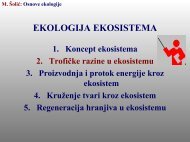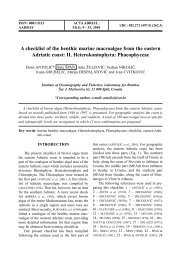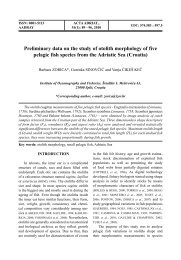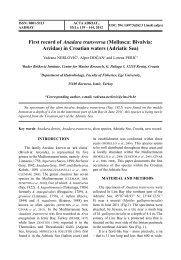Digenea trematodes in fish of the North Adriatic Sea
Digenea trematodes in fish of the North Adriatic Sea
Digenea trematodes in fish of the North Adriatic Sea
You also want an ePaper? Increase the reach of your titles
YUMPU automatically turns print PDFs into web optimized ePapers that Google loves.
124 ACTA ADRIATICA, 48(2): 115-129, 2007<br />
on <strong>the</strong> lateral part <strong>of</strong> <strong>the</strong> body, under ventral<br />
sucker. Uterus forms many coils, between caeca<br />
and testes. Eggs, dark brown, 0.02 x 0.02 mm.<br />
Discussion<br />
Metadena depressa is not a very well known<br />
parasite. Accord<strong>in</strong>g to JANISZEWSKA (1953) it is<br />
identical to Distomum depressum, and described<br />
by STOSSICH (1886, 1898) and CARUS (1885) from<br />
Dentex dentex. Because <strong>of</strong> <strong>the</strong> characteristic<br />
morphologies <strong>of</strong> members <strong>of</strong> <strong>the</strong> genus Metadena,<br />
LINTON (1910), JANISZEWSKA (1953) suggested<br />
<strong>the</strong> name Metadena depressa <strong>in</strong>stead <strong>of</strong> Distomum<br />
depressum Stossich (1883). This species is<br />
quite different from o<strong>the</strong>r parasites <strong>of</strong> Metadena<br />
genus, like M. pagrosomi Yamaguti, (1938) and<br />
M. crassulata L<strong>in</strong>ton (1910), especially due to<br />
<strong>the</strong> structure <strong>of</strong> <strong>the</strong> oral sucker, spherical muscular<br />
disc and location <strong>of</strong> <strong>the</strong> uterus.<br />
Family: Lepocreadiidae Odhner, 1905<br />
Genus: Lepocreadium Stossich, 1903<br />
Species: Lepocreadium album (Stossich,<br />
1890)<br />
Fig. 11. Lepocreadium album, adult<br />
Synonyms: Distomum album Stossich,1890;<br />
Allocreadium album Stossich,1901<br />
Host: Diplodus annularis L. (Annular sea<br />
bream), D. sargus L. (White sea bream)<br />
Sites: Intest<strong>in</strong>e <strong>of</strong> 6.7% Diplo dus annularis<br />
L. and 5.8% D. sargus L.<br />
Localities: <strong>North</strong> <strong>Adriatic</strong> <strong>Sea</strong><br />
Description<br />
The body oval, 2 mm x 0.90 mm. Cuticula<br />
covered with sp<strong>in</strong>es. Oral sucker subterm<strong>in</strong>al,<br />
0.20 mm <strong>in</strong> diameter. Prepharynx short, pharynx<br />
spherical, 0.18 mm x 0.15 mm. Oesophagus<br />
short. The curved caeca reach <strong>the</strong> posterior part<br />
<strong>of</strong> <strong>the</strong> body. Ventral sucker spherical, equal to<br />
oral sucker, located under <strong>the</strong> caeca bifurcation,<br />
on <strong>the</strong> end <strong>of</strong> <strong>the</strong> first third <strong>of</strong> <strong>the</strong> body. Testes<br />
two, subspheric tandem, <strong>in</strong> <strong>the</strong> second part <strong>of</strong> <strong>the</strong><br />
body near <strong>the</strong> ovary, 0.25 x 0.20 mm. Vesicula<br />
sem<strong>in</strong>alis visible, situated above <strong>the</strong> testes. Cirrus<br />
pouch situated above ventral sucker 0.20 x<br />
0.09 mm, compris<strong>in</strong>g vesicula sem<strong>in</strong>alis <strong>in</strong>terna,<br />
pars prostatica and ductus eiaculatorius. Genital<br />
atrium wide, visible above ventral sucker. Genital<br />
pore median, <strong>in</strong> <strong>the</strong> level <strong>of</strong> ventral sucker.<br />
Ovary oval, pretestical, 0.15 x 0.12 mm. Vitellaria<br />
fill<strong>in</strong>g all <strong>the</strong> lateral place <strong>of</strong> <strong>the</strong> body, from<br />
ventral sucker until <strong>the</strong> end <strong>of</strong> <strong>the</strong> body. Uterus<br />
<strong>in</strong> <strong>the</strong> middle with low number <strong>of</strong> <strong>the</strong> eggs, 0.09<br />
x 0.05 mm. Excretory pore posterior, term<strong>in</strong>al.<br />
Discussion<br />
This trematod was found <strong>in</strong> <strong>Adriatic</strong> <strong>Sea</strong> for<br />
<strong>the</strong> first time by STOSSICH (1890) and SEY (1970)<br />
<strong>in</strong> <strong>the</strong> <strong>fish</strong> Spondyliosoma cantharus and Oblada<br />
melanura. RADUJKOVIĆ et al. (1989) isolated<br />
it <strong>in</strong> 11.8% <strong>of</strong> Diplodus annularis. It was found<br />
<strong>in</strong> <strong>the</strong> Mediterranean by PAPOUTSOGLOU (1976),<br />
PAGGI & ORECCHIA (1976), ORECCHIA & PAGGI<br />
(1978), FISCHTAL (1980,1982) and SAAD-FARÈS<br />
(1985) <strong>in</strong> Boops boops, Spondyliosoma cantharus,<br />
Chromis chromis, Diplodus annularis, D.<br />
sargus, D. vulgaris, Spicara maena, S. flexuosa,<br />
S. smaris, Oblada melanura, D. puntazzo,<br />
Sparus aurata, Sarpa salpa, Pagrus pagrus and<br />
Blennius pavo. OKTENER (2005) found <strong>the</strong> parasite<br />
<strong>in</strong> <strong>fish</strong> Boops boops, Diplodus annularis, D.<br />
vulgaris, D. sargus, Spondyliosoma cantharus,








